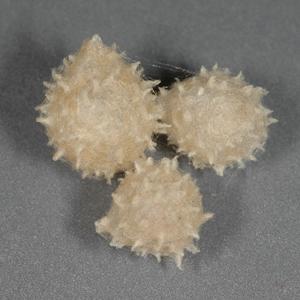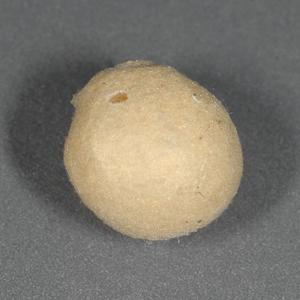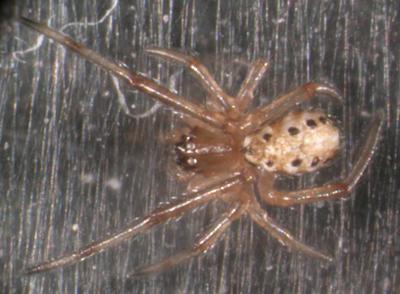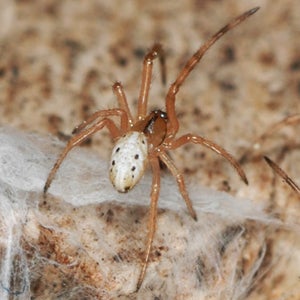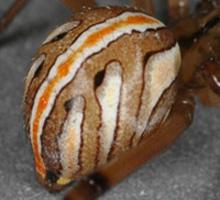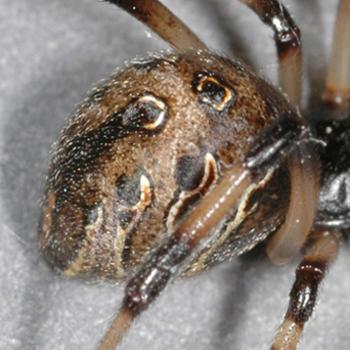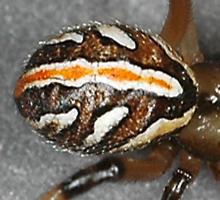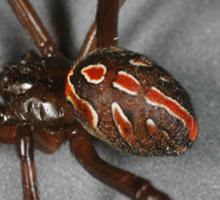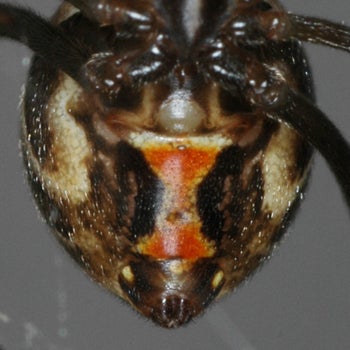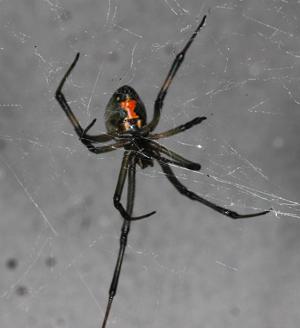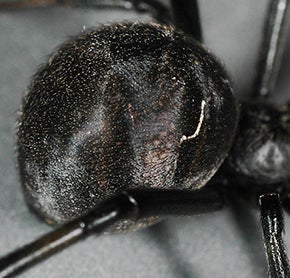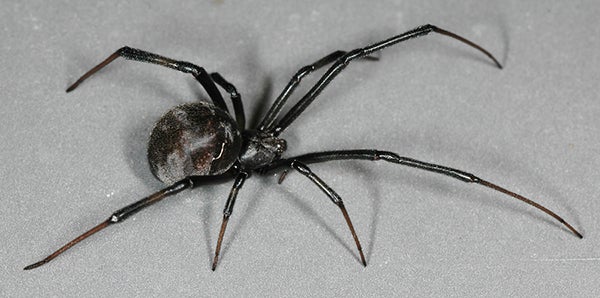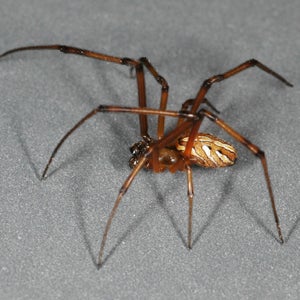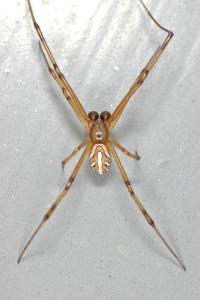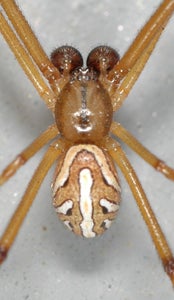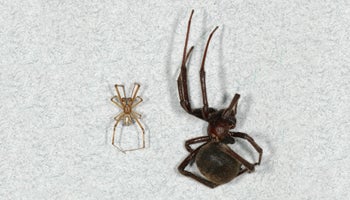How to identify (and misidentify) Brown Widow
The brown widow spider, Latrodectus geometricus, is not native to the United States. For decades, it lived only in peninsular Florida in the U.S. but in the first decade of the 21st century, it spread remarkably quickly, is now found from Texas to South Carolina and is well established in the urban areas of Los Angeles, San Diego and surrounding suburbs. In the western United States, accurate identification of this spider can be difficult. The brown widow is a tan spider with a series of white stripes. Unfortunately, immatures of the native black widow spider, Latrodectus hesperus, also are tan with white stripes and are frequently mistaken for brown widows. There is TREMENDOUS variation for both of these species as they grow from babies to adults. In order to master identifying them, many specimens need to be examined. Below is a pictorial comparison of the two species with ways to differentiate between them. Many people send in orb weavers orb weavers of the genera Neoscona and Araneus. Orb weavers have spines on thier legs, widow spiders have no spines. Please check the internet to identify orb weavers to reduce the chance of misidentification.
Egg sac
This is the easiest way to tell a brown widow from a black widow. The egg sac of the brown widow is round and yellow with many little silk spikes sticking out from its surface, looking like a big pollen grain or one of those harbor mines from World War II. The egg sac of the western black widow is either round or pointed at the top, yellow and smooth.
| Brown widow egg sacs | Black widow egg sacs |
Newly emerged spiderlings
Once the babies emerge from the egg sac, things get a little confusing. Although the brown widow may look a little bit like the adult that it is going to grow up to be, the western black widow looks NOTHING like a black widow female. Baby western black widows have tan legs, tan cephalothorax with a black longitudinal stripe and a white abdomen with black spots. Although these two baby spiders look somewhat alike, the brown widow babies have more brown on them.
| Brown widow baby spiderling (live) | Black widow baby spiderling (live) |
| Brown widow baby spiderling (dead) | Black widow baby spiderling (dead) |
Where the problem comes in
The problem with properly identifying mature brown widows from immature western black widows comes when the spiders are about half grown. The brown widows change a little but western black widows change a lot. The key to properly identifying the two species lies in those black dots that you can see on the spiders’ abdomen. Of secondary usefulness, the central longitudinal stripe on the top part of the abdomen can likewise help differentiate species. As both species of spiders grow bigger from babies, the abdomen background turns darker colors and stripes appear on the abdomen.
| Brown widow female abdomen | Western black widow immature abdomen |
At first these spiders may look very similar. However, pay attention to the lateral diagonal stripes on the abdomen. In the brown widow, it looks something like a finger of a hand projecting upward and the finger is holding a large black rectangular blotch. Compare that to the immature western black widow and you see that the light colored stripe is more of a straight line or may be flattened a little at the top. However, the black dot at the top of the light colored line is small and blobby.
The next thing to look at is the longitudinal stripe. In the brown widow, it only extends about half way up the abdomen from the rear. In the western black widow, the stripe extends almost all the way up the abdomen. Also notice that the forwardmost dot in the brown widow is isolated from the rest of the stripe and is about twice as wide as long. The same place that would have the dot on the immature western black widow is continuous with the stripe (at least in the early stages of life).
As western black widows mature, they develop more dark pigment in the background area, the stripes start to break up into nebulous isolated patches and eventually disappear as the spider continues to molt and adds darker pigment on its way to turning completely black. Sometimes there is a vivid orange or red stripe in the middle of the longitudinal abdominal stripe. This will also fade and get thinner as the spider matures.
The brown widow can have some orange in that longitudinal stripe but it will never be bright red. Below will be a series of pictures of brown widows then black widows to show you the great variation in each species as they mature. Realize that distinguishing the two species takes lots of practice and examining lots of specimens. Brown widows can vary from almost a white to being almost as dark as a black widow.
Brown widow abdomens showing lighter colors (upper left), orange in longitudinal stripe and very pale blotches at the top of the diagonal stripes (upper right), a dark abdomen with very dark blotches on top of the diagonal stripes (lower left) and a strange one with orange tint all over (lower right).
Immature western black widow abdomens showing typical tan background with orange-red longitudinal stripe (left), showing a bit darker background coloration but the small black dots on top of the white diagonal stripes are barely visible, notice how the central longitudinal stripe undulates slightly and the orange stripe pinches off at places (center), and another darkening specimen where the central red longitudinal stripe is now breaking up into individual spots. These spots will dissipate as the spider grows and darkens to black (right).
| On the front facing portion of the brown widow abdomen (left), the light colored lines do not converge in the middle whereas in the immature black widow (right), the line is continuous. In addition, the forwardmost spot in the middle of the brown widow abdomen is as wide as long or often wider than long. In the immature black widow, the forwardmost spot is longer than wide and looks like an arrowhead. In the black widow, these markings become nebulous as the spider loses its light coloration and becomes solid black. Sometimes the adult female black widow retains a portion of the continuous line in the front part of the abdomen. |
|
| The hourglass of the brown widow (left) is wider on the bottom than the top and the bottom half of the hourglass is larger than the top half and is “puffy” with a fuzzy, indistinct outline. In the immature black widow, (right) the top half of the hourglass is wider than the bottom and the top half of the hourglass is larger than the bottom half with the outline being more distinct and crisper. | |
Adult females
Many sources will tell you that a brown widow is tan and has an orange hourglass. What really is the case is that most are like that but there is tremendous variation as you can see with the pictures above. Although the typical case is tan with an orange hourglass, some brown widows are very dark and have a hourglass that isn’t exactly vivid red but is red-orange enough that you wouldn’t say it looked just orange; these can be mistaken for black widows. On the close up, you can see that it looks like a red hourglass with an orange border.
| Typical tan brown widow | Brown widow hourglass |
| Dark brown widow with red hourglass | Above: brown widow that is almost as dark as a black widow. Notice that the abdomen isn’t as shiny and reflective as that of a black widow and there are traces of brown coloration. It was initially identified by its bottom-heavy hourglass and verified when it produced a spiky egg sac typical for the species. |
| Above: brown widow that is almost as dark as a black widow. Notice that the abdomen isn’t as shiny and reflective as that of a black widow and there are traces of brown coloration. It was initially identified by its bottom-heavy hourglass and verified when it produced a spiky egg sac typical for the species. | |
Western black widow females
Of course, the familiar pattern of the black widow is very striking and looks nothing like the baby that emerged from the egg sac.
Males
Males of both species are smaller than the females but the brown widow males are much smaller than black widow males. Both species retain much of the coloration of the juveniles. On very rare occasion, western male black widows can be black with white stripes.
| Male western black widows | Male western black widows | Close up of male western black widow spider showing juvenile abdominal coloration |
Size comparisons
Below are pictures of male and female brown and western black widows taken with the same scale so their sizes can be compared.
| Male and female brown widow | Male and female western black widow |
